
About Japanese Pottery
In Japan, there are many crafts called “Dento Kogei (traditional crafts)”, which are made using skills and techniques that have been passed down over the years.
Many traditional crafts are made from materials produced in the region and cannot be made anywhere else.
This article focuses on one of the most popular traditional pottery, Togei.
What is Togei?
Togei is the art of molding clay and firing it at high temperatures to make porcelain and other forms of pottery.
Generally, Ceramics indicate both “Pottery” and “Porcelain” both are also called Yakimono, which is equivalent to the English word “Ceramics”.
The table below shows the characteristics of each.
Pottery
Famous Pottery|Mashiko-yaki, Hagi-yaki, etc. Care|After purchase, soak in water or lukewarm water for about half a day. Water absorption prevents oil and odors from soaking in when cooking. When drying, do not allow the vessels to overlap each other, and store them only after they are completely dry. |
Porcelain
- Produced using stone powder made from crushed and powdered ceramic stone.
- Fired at a high temperature of over 1,300 degrees Celsius.
- Smooth and transparent like glass.
- High heat resistance due to high-temperature firing.
- Low water absorption and high hardness.
- Can be used in microwave ovens.
*If painted with gold or silver decorations as decoration, No.
Famous porcelain ware|Hasami-yaki, Kutani-yaki, Arita-yaki
How to care for porcelain|It does not need to be watered first like ceramics.
Porcelain is more durable than ceramics, but it is thin and prone to chipping and cracking.

Representative Japanese six potteries
The “Nihon Rokkoyo (The Six Ancient Kilns of Japan)” is the collective name for six kilns that have continued to produce pottery to the present day, while inheriting pottery techniques that have continued since the Jomon period.
The six kilns are Echizen, Seto, Tokoname, Shigaraki, Tamba and Bizen.
These were recognized as “Japanese Heritage” in 2017.
It is said that Japanese ceramic techniques mostly derive from China and Korea.
However, only the Six Ancient Kilns of Japan are distinguished as genuine Japanese pottery.
- Echizen Yaki / Fukui Prefecture
Echizen pottery has a rustic texture and is made of red clay, which is locally available and can withstand high temperatures due to its high iron content.
https://www.town-echizen.jp/en/
- SetoYaki / Aichi Prefecture
Seto-yaki is pottery with colorful paintings and lines added using a variety of glazes.
It was the only pottery made with glaze in the medieval period.
https://www.setoyakishinkokyokai.jp/
- TokonameYaki / Aichi Prefecture
Uses iron-rich pottery clay from the Chita Peninsula.
http://www.tokonameyaki.or.jp/
- Shigaraki Yaki / Shiga Prefecture
Shigarayaki is made of coarse clay and is highly fire-resistant.
Large ceramics are often made.
https://www.593touki.jp/shigarakiyaki.html
- Tamba Yaki / Hyogo Prefecture
This color uses “natural glaze” without artificial glaze.
This pottery is popular not only for practical use but also for ornamental purposes.
https://kogeijapan.com/locale/en_US/tambatachikuiyaki/
- Bizen Yaki / Okayama Prefecture
Bizen Pottery is fired for a long time without painting or glaze.
This is the ultimate simple pottery made to enjoy the texture of the clay.
Ceramic to decorate the dining table
The dish tray in which food is placed is called a “Utsuwa”.
In Japanese households, each side dish is usually served on a different dish and eaten separately.
Therefore, the amount of dishes needed is also the amount of containers needed.
It has long been said that a well-balanced meal should consist of “one soup and three types of vegetable,” and many households still follow this basic rule.
Ichiju sanzai” refers to a menu consisting of one soup and three side dishes.
Ichiju: Ichi means one, jyu means soup. As the name implies, it is a soupy dish, such as miso soup.
San-sai: San means three, Sai means dish/meal. It consists of one “main dish” and two “side dishes” (three side dishes in total).
This “Ichi jyu San sai set” is served with rice (staple food).
Basically, each side dish is served on a separate plate.
For example, sautéed spinach is placed in a dish with yellow lines to enhance the green color, grilled fish is placed on yakimono to express the beauty of nature, and if the season is early spring, the drinking cups are made of pottery with cherry blossoms painted on them, provoking thoughts of the cherry blossoms that will bloom soon.
Nowadays, porcelain with simple shapes, which is easy to take care of and hard to break, is preferred for ordinary dining tables.
However, even today, meals are served in a variety of dishes at ryotei or Ryokan (traditional Japanese restaurant or hotel).
Enjoying these dishes is one of the best parts of traveling.

Pottery Techniques
Here are some basic pottery techniques.
If you are interested in pottery, we encourage you to actively participate in pottery workshops.
What you can make with pottery:
Vases, dishes, cups, chopstick rests, wind chimes, aroma lamps, musical instruments, dolls, Christmas ornaments, etc.
<Terms frequently used in Pottery>
Tebineri (hand forming)
A technique in which clay is shaped by stretching it with the fingertips. There are basically no restrictions on the shapes of ceramics that can be made using the hands alone.
It is possible to make not only everyday vessels such as tableware and cups, but also ornamental items such as large pots and chopstick rests.
Rokuro (Potter’s Wheel)
The motorized or mechanical potter’s wheel is operated by stepping on a pedal at the foot of the potter’s wheel to rotate the stand.
By using centrifugal force, it is possible to make beautiful vessels of well-defined shapes.
However, because the speed of rotation is very fast, it takes some practice to become proficient.
Also, since there is a limit to the shapes that can be formed, the rokuro is not suitable for certain items that you may want to make.
Typical shapes include vases, tableware, and jars.
Etsuke (Painting)
In the process of painting, colors are applied directly to the pottery, which is then covered with a transparent glaze before firing.
Famous pottery with painted decoration|Kutani ware, Imari ware, and Arita ware.
Yuyaku/ Uwagusuri (Glaze)
A glassy coating material when glaze is applied to the surface of unglazed ceramics and fired again.
Glazes give color, luster, etc., as well as increase the strength of the pottery and protect it from water and dirt by decreasing its water absorbency.
The variety of glazes is unlimited, depending on raw materials and formulations.
Hori/ Kizami (Carving)
The surface of a vessel is decorated with an uneven surface using a stick or blade.
This technique has been used since Jomon pottery, and there are a variety of techniques.
Nerikomi (Kneading)
Two or more types of clay of different colors and the same hardness are kneaded together before forming.
Pop-Culture
Comics are also popular in Japan.
Japanese comics are drawn in a variety of genres, and of course, there are comics about ceramics.
Even if you are not interested in comics, you may be interested in a comic about ceramics in Japan.
The most famous ceramic comic.
The theme is Hagi Yaki.
Complete in 15 volumes.
Sequel to Hi ga Hashiru above.
Complete in 9 volumes.
The story is about the main character, Haruka, who is so impressed by a piece of pottery that she quits her job and goes to apprentice herself to the artist.
The theme is Bizen Yaki.
A story of Utsuwa and love, set in Hasami, Nagasaki.
The theme is Hasami Yaki, famous for painted Utsuwa.
A manga about ceramic art featuring a man. The main character is a gentle potter, but in fact, his secret identity is that he is an “underhanded potter” who solves all kinds of troubles related to ceramics for rewards of tens of millions of yen.
It is a story about a girl from England who is fascinated with being a potter and trains herself in the art.
The theme is Shigaraki ware.
Although not a pottery manga, it is a long-selling comic that colorfully depicts Japanese cuisine, vessels, and other aspects of Japanese culture.
One of the main characters, “Yuuzan Umehara,” is a potter.
Summary
In this article, we introduced one of Japan’s traditional crafts, ceramics.
Ceramics is still one of the most popular crafts today, with workshops being held all over Japan.
If you have a chance to attend a pottery workshop, please do so.
We will continue to send out information about various Japanese crafts in the future, so please look forward to it!
Interested in exploring a diverse range of Japanese handmade items?
Our platform “niji ” has selection of products crafted by talented Japanese artists. Discover unique creations from here!

